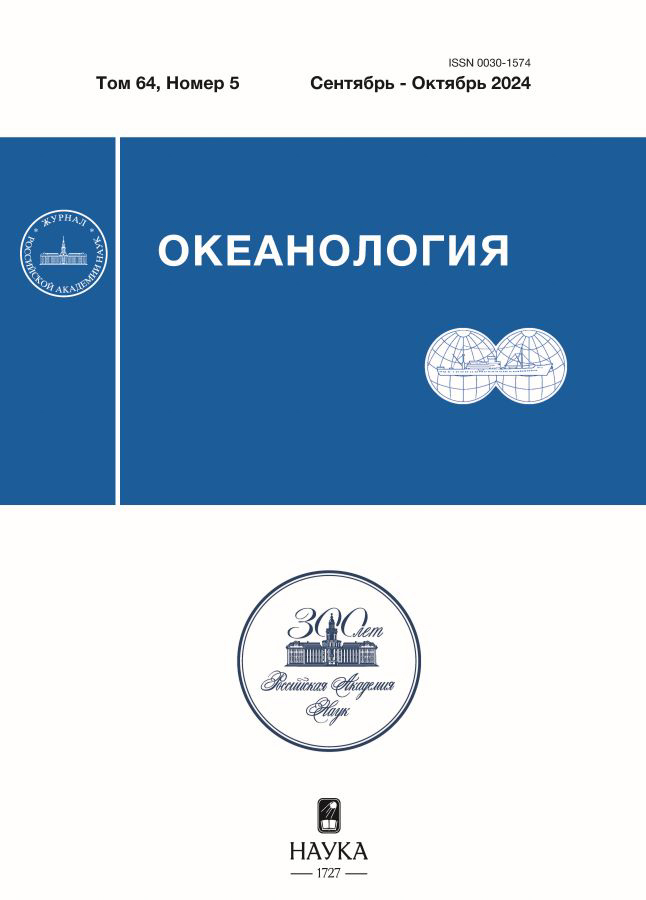Oceanological studies of the russian sectors of the baltic sea in the year 2023
- Authors: Bubnova E.S.1,2, Sivkov V.V.1, Muratova A.A.1,2, Mosharov S.A.1,2, Korobchenkova K.D.1,2, Dudkov I.Y.1,2, Mosharova I.V.1, Polukhin A.A.1, Aleksandrov S.V.1, Artamonov A.Y.3
-
Affiliations:
- Shirshov Institute of Oceanology, Russian Academy of Sciences
- Immanuel Kant Baltic Federal University
- A.M. Obukhov Institute of Atmospheric Physics of the Russian Academy of Sciences
- Issue: Vol 64, No 5 (2024)
- Pages: 850-852
- Section: Информация
- URL: https://journals.eco-vector.com/0030-1574/article/view/681406
- DOI: https://doi.org/10.31857/S0030157424050129
- EDN: https://elibrary.ru/OFIDJJ
- ID: 681406
Cite item
Abstract
The environmental monitoring of the Russian sectors of the Baltic Sea was continued through three expeditions t in 2023: the 55th cruise of the P/V “Akademik Sergei Vavilov” (April), the 54th and 55th cruises of the R/V “Akademik Boris Petrov” (November and December, respectively). Seasonal quantitative estimates of hydrological-hydrochemical and hydrobiological parameters, carbon dioxide fluxes at the water-air interface were obtained, and the geological and geomorphological conditions of the study areas were clarified. Influence of the Neva River to the eastern part of the Gulf of Finland was stable in all seasons and could be traced at a distance of up to 30 nautical miles from the Neva Bay. The South-Eastern Baltic bottom layer experienced extensive hypoxia and mosaic euxunia. Significant aeration of bottom waters occurred in December due to the combined influence of seasonal convection and downwelling resulting from a series of storms. In both study areas, high values of integral primary production were obtained in April, which were two orders of magnitude higher than the December values. The concentration of chlorophyll “a”, accordingly, differed by an order of one magnitude. The Gulf of Finland was an emitter of carbon dioxide into the atmosphere, especially in April, while the South-Eastern Baltic absorbed carbon dioxide in April and was an area of weak emissions in November and December.
Full Text
About the authors
E. S. Bubnova
Shirshov Institute of Oceanology, Russian Academy of Sciences; Immanuel Kant Baltic Federal University
Author for correspondence.
Email: bubnova.kat@gmail.com
Russian Federation, Moscow; Kaliningrad
V. V. Sivkov
Shirshov Institute of Oceanology, Russian Academy of Sciences
Email: bubnova.kat@gmail.com
Russian Federation, Moscow
A. A. Muratova
Shirshov Institute of Oceanology, Russian Academy of Sciences; Immanuel Kant Baltic Federal University
Email: bubnova.kat@gmail.com
Russian Federation, Moscow; Kaliningrad
S. A. Mosharov
Shirshov Institute of Oceanology, Russian Academy of Sciences; Immanuel Kant Baltic Federal University
Email: bubnova.kat@gmail.com
Russian Federation, Moscow; Kaliningrad
K. D. Korobchenkova
Shirshov Institute of Oceanology, Russian Academy of Sciences; Immanuel Kant Baltic Federal University
Email: bubnova.kat@gmail.com
Russian Federation, Moscow; Kaliningrad
I. Yu. Dudkov
Shirshov Institute of Oceanology, Russian Academy of Sciences; Immanuel Kant Baltic Federal University
Email: bubnova.kat@gmail.com
Russian Federation, Moscow; Kaliningrad
I. V. Mosharova
Shirshov Institute of Oceanology, Russian Academy of Sciences
Email: bubnova.kat@gmail.com
Russian Federation, Moscow
A. A. Polukhin
Shirshov Institute of Oceanology, Russian Academy of Sciences
Email: bubnova.kat@gmail.com
Russian Federation, Moscow
S. V. Aleksandrov
Shirshov Institute of Oceanology, Russian Academy of Sciences
Email: bubnova.kat@gmail.com
Russian Federation, Moscow
A. Yu. Artamonov
A.M. Obukhov Institute of Atmospheric Physics of the Russian Academy of Sciences
Email: bubnova.kat@gmail.com
Russian Federation, Moscow
References
- Полухин А.А., Казакова У.А., Гусак Г.В., и др. Структура вод и поток углекислого газа над континентальным склоном моря Лаптевых и в проливе Вилькицкого в осенний сезон // Океанология. 2023. Т. 63. № 5. С. 733–744.
- Ульянова М.О., Сивков В.В., Александров С.В.и др. Исследования Балтийского моря в 61-м рейсе НИС “Академик Иоффе” // Океанология. 2023. Т. 63. № 5. С. 862–864.
- Ульянова М.О., Сивков В.В., Баширова Л.Д. и др. Океанологические исследования Балтийского моря в 56-м рейсе ПС “Академик Иоффе” // Океанология. 2022. Т. 62. № 1. С. 162–164.
- Ульянова М.О., Сивков В.В., Баширова Л.Д. и др. Океанологические исследования Балтийского моря в 51-м рейсе ПС “Академик Сергей Вавилов” // Океанология. 2022. Т. 62. № 4. С. 667–669.
Supplementary files










